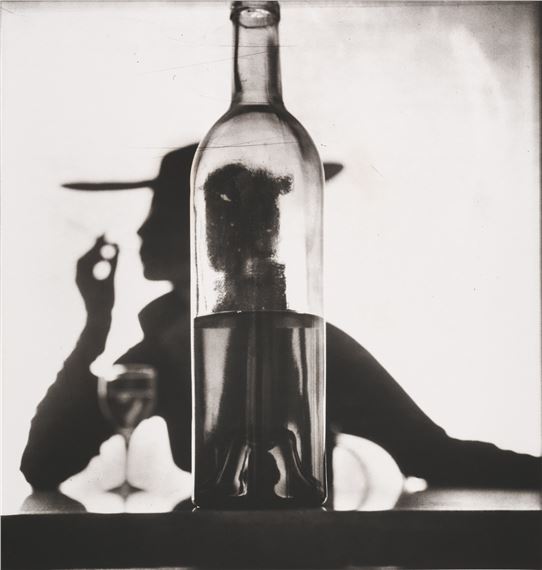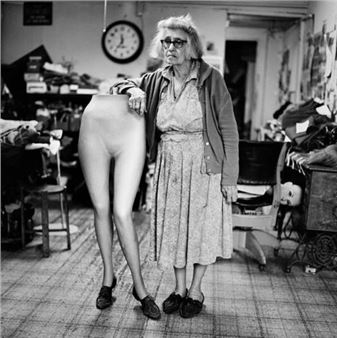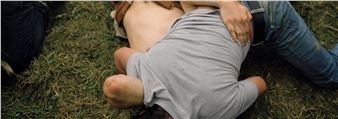Nightlife
Marlborough New York is pleased to present Nightlife, a group exhibition featuring iconic images by six of the most prominent photographers of the twentieth century whose images all celebrate the nocturnal hours of city life. Featuring works by Berenice Abbott, BrassaĂŻ, Bill Brandt, Helmut Newton, Irving Penn, and Weegee, this exhibition unites photographs which capture underground subcultures, illicit activities, subversive fashions, and those otherwise existing on the fringes of society searching for hedonistic escapism. Ultimately, Nightlife will pay homage to the joyous freedoms experienced from dusk to dawn.
Working in Paris and London respectively, Brassaï and Bill Brandt captured the joie de vivre of night-goers in the 1930s, as the recent invention of the flashbulb allowed for the new genre to be possible. Brassaï would often walk around the city at night, carrying his camera, tripod, magnesium flash powder and a box of 24 glass plate negatives to photograph Parisian nightlife. Wandering the dimly lit streets, he captured the excessive nightlife of the demi-monde in bars and brothels, creating a unique visual topography of the city and a colorful chronicle of its subcultures. Inspired by Brassaï’s Paris de Nuit published in 1936, Brandt’s second photobook, A Night in London, chronicles the events transpired on a London evening out, oscillating between capturing a variety of social classes. Interested in shadows, Brandt often used the darkroom to alter his photographs in decisive ways, using the “day for night” technique employed by cinematographers to transform images photographed in daylight into night scenes.
New York-based photographers Berenice Abbott and Weegee employed a documentarian approach when photographing their nighttime scenes. Abbott is most notable for her book Changing New York, which documents the modern skyscrapers, harbors, highways, city squares, neighborhoods, storefronts of New York City as it swiftly evolved. On view in this exhibition will be New York at Night, one of the most iconic images featured in Changing New York which depicts an aerial view looking north on New York’s West Side. Taking a bleaker approach, legendary news photographer Weegee would listen to a police scanner radio installed in his 1938 Chevrolet in order to arrive first at crime scenes to produce gruesome, yet compassionate, photographs of murders, fires, car accidents, burglaries, and brawls.
With a penchant for eccentric trends influenced by nightlife subcultures, Helmut Newton and Irving Penn both produced fashion photography for Vogue magazine. As one of fashion’s most prolific photographers, Newton is most notable for his provocative images which draw from influences such as film noir, Expressionist cinema, S & M, and surrealism. Penn’s fashion photography exercised a more pared-down aesthetic, often staging his motifs in front of white backdrops with minimal lighting.
Nightlife celebrates a pivotal period in the history of photography, when the medium firmly established its position as an independent art form. The show also pays tribute to the critical role Marlborough played at the forefront of exhibiting photography during the 1970s and 80s. Many of the photographs on view have not been seen in decades and are from the gallery’s extensive collection. Marlborough’s program continues to highlight historical shows and artist estates alongside leading contemporary artists.

Recommended for you
Marlborough New York is pleased to present Nightlife, a group exhibition featuring iconic images by six of the most prominent photographers of the twentieth century whose images all celebrate the nocturnal hours of city life. Featuring works by Berenice Abbott, BrassaĂŻ, Bill Brandt, Helmut Newton, Irving Penn, and Weegee, this exhibition unites photographs which capture underground subcultures, illicit activities, subversive fashions, and those otherwise existing on the fringes of society searching for hedonistic escapism. Ultimately, Nightlife will pay homage to the joyous freedoms experienced from dusk to dawn.
Working in Paris and London respectively, Brassaï and Bill Brandt captured the joie de vivre of night-goers in the 1930s, as the recent invention of the flashbulb allowed for the new genre to be possible. Brassaï would often walk around the city at night, carrying his camera, tripod, magnesium flash powder and a box of 24 glass plate negatives to photograph Parisian nightlife. Wandering the dimly lit streets, he captured the excessive nightlife of the demi-monde in bars and brothels, creating a unique visual topography of the city and a colorful chronicle of its subcultures. Inspired by Brassaï’s Paris de Nuit published in 1936, Brandt’s second photobook, A Night in London, chronicles the events transpired on a London evening out, oscillating between capturing a variety of social classes. Interested in shadows, Brandt often used the darkroom to alter his photographs in decisive ways, using the “day for night” technique employed by cinematographers to transform images photographed in daylight into night scenes.
New York-based photographers Berenice Abbott and Weegee employed a documentarian approach when photographing their nighttime scenes. Abbott is most notable for her book Changing New York, which documents the modern skyscrapers, harbors, highways, city squares, neighborhoods, storefronts of New York City as it swiftly evolved. On view in this exhibition will be New York at Night, one of the most iconic images featured in Changing New York which depicts an aerial view looking north on New York’s West Side. Taking a bleaker approach, legendary news photographer Weegee would listen to a police scanner radio installed in his 1938 Chevrolet in order to arrive first at crime scenes to produce gruesome, yet compassionate, photographs of murders, fires, car accidents, burglaries, and brawls.
With a penchant for eccentric trends influenced by nightlife subcultures, Helmut Newton and Irving Penn both produced fashion photography for Vogue magazine. As one of fashion’s most prolific photographers, Newton is most notable for his provocative images which draw from influences such as film noir, Expressionist cinema, S & M, and surrealism. Penn’s fashion photography exercised a more pared-down aesthetic, often staging his motifs in front of white backdrops with minimal lighting.
Nightlife celebrates a pivotal period in the history of photography, when the medium firmly established its position as an independent art form. The show also pays tribute to the critical role Marlborough played at the forefront of exhibiting photography during the 1970s and 80s. Many of the photographs on view have not been seen in decades and are from the gallery’s extensive collection. Marlborough’s program continues to highlight historical shows and artist estates alongside leading contemporary artists.

 ARTISTS
ARTISTS













